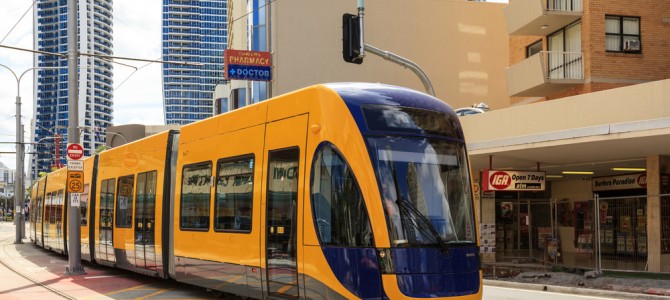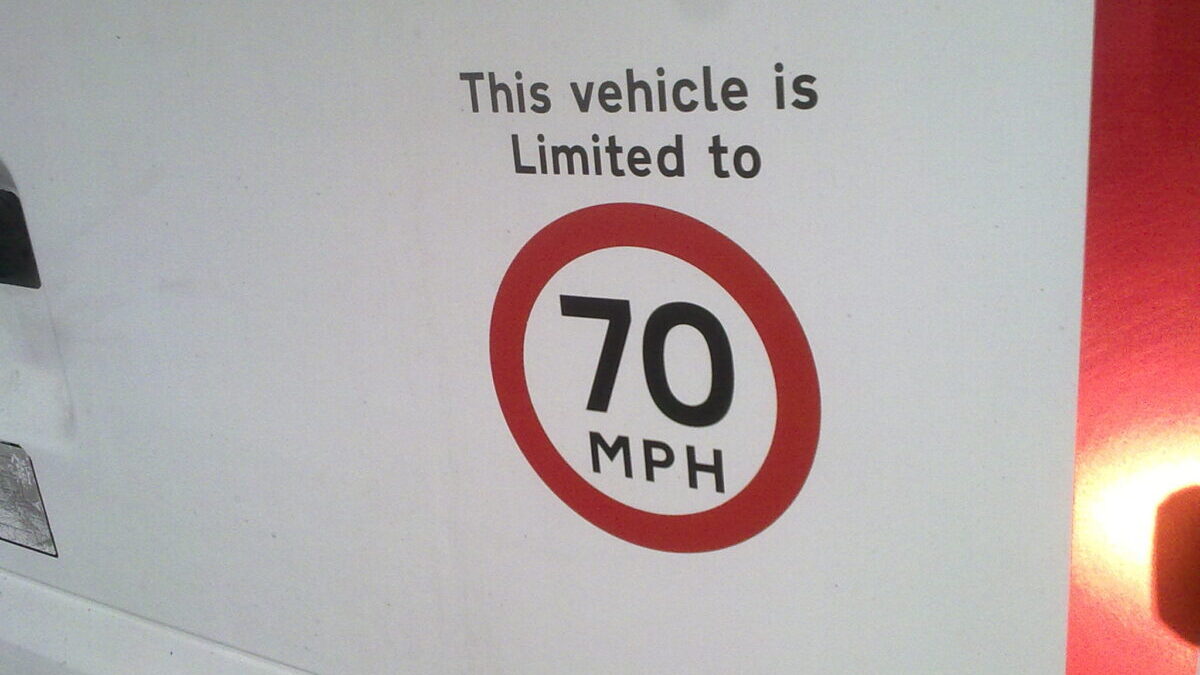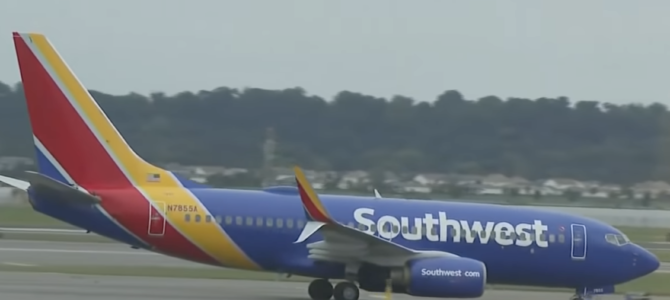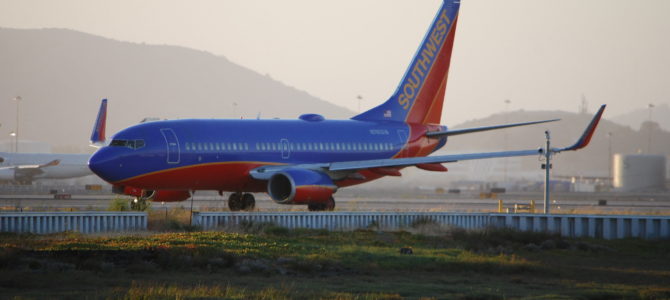
The United States has just dropped from number 1 in transportation infrastructure to number 16, behind Germany, Spain, and Denmark. 60 Minutes has just run a special on the dilapidated state of our infrastructure nationwide. While our bridges are crumbling, we grow ever more frustrated with our sinking global status. We want to be world-class again.
But are light rails and trolleys what we need to rebuild world-class American cities? The easy-going liberals of Portland relish that their city is consistently hailed as having a “world-class” transit system, complete with buses, light rail, and streetcars. Portland sent its first “sleek and modern Portland Streetcar“ on a maiden voyage in 2001. Fans of the streetcar have declared the city’s light-rail system, “MAX Light Rail,” as (of course) world-class.
Los Angeles has decided that a light-rail station that connects to LAX is worth $200 million. Mayor Garcetti trumpeted, “World-class cities have world class airports and world class transit.” Meanwhile, Rep. Sheila Jackson Lee has written a bona fide light-rail sermon, titled “Houston Needs to Keep Pushing Forward for A World Class Light Rail System,” in which she praised METRO Rail for having “100 million boarding’s [sic] since service began in January of 2004. Eighteen light-rail vehicles (LRVs) have traveled more than four million miles and achieved this record four years ahead of schedule.” From my home city of Seattle come the sage words of Sound Transit Board member Dave Enslow, who proclaimed the rail lines, which almost always fall behind ridership forecasts, “a 100 year investment.”
Some locals know that Central Link, Seattle’s first light rail line, was North America’s most expensive light rail at over $100,000 per yard when it opened in 2009. It serves less than 3 percent of total commuters, as only 3 to 4 percent of Seattle commuters get to work through mass transit. Apparently flush with cash in 2014, the City of Seattle will now shell out $10 million to study new streetcar lines. Yes, to study them. Mike Lindbolm of the Seattle Times writes, “At least four routes would be examined…all once served by streetcar tracks before the citywide system was abandoned in 1941.” Yes, abandoned. Did we ever stop to think that perhaps there was a reason for that? Like, say, the much niftier invention of trolley buses, since as it turns out the invention of the wheel was all it’s cracked up to be?
Everyone Pays for Trains that Almost No One Uses
Nevertheless, almost a decade after the initial plan to build the South Lake Union Streetcar (also called the SLU Trolley and affectionately titled S.L.U.T. by critics), it accounts for just1 percent of the region’s passenger boardings and is heavily dependent on its sugar daddy, the City of Seattle. In 2005 at the time the project was announced, opposing Councilman Steinbrueck, referencing the necessary accompaniment of new sidewalks, re-paved streets, and streetlights, called the S.L.U.T. a “luxury.” John Fox of the Seattle Displacement Coalition offered the most telling critique: “[It’s] not that there shouldn’t be a streetcar, but that it’s more of a real-estate toy that shouldn’t be propped up by more vital services around the city.” (Emphasis added.) Seattle drops money on mass transit like rich cryptozoology enthusiasts drop money on expeditions to find Big Foot—the successes of which are comparable.
In a previous piece, I discussed the radical ideological roots of the mass transit scam. There are some, such as Seattle City Councilwoman Kshama Sawant (who urged Boeing factory workers to seize control of the plant and begin building mass transit) who believe centralization and a complete shift to mass transit are crucial for cities’ futures. Others simply buy into this myth that light rail and trolleys will somehow elevate their cities to the next level of sophistication—the very prospect of which is ignorant, at best, and self-indulgent, at worst.
The overwhelming evidence shows that these mass transit projects do little to improve our quality of life, in terms of easing congestion and expanding access to jobs and, despite popular perception, have no significant net environmental benefits since they rarely succeed in their express goal of removing cars from the road or decreasing congestion-induced idle times, a frequently cited contributor to greenhouse-gas emissions. As the satirical online newspaper The Onion reported, “98% of Americans favor public transportation for others.” That statistic may be fake, but we’ve all experienced the sentiment.
An Exorbitant Game of Keeping Up with the Jonesvilles
Even the writers of “The Simpsons” seem to understand the comical nature of light-rail adoption in American cities, brilliantly satirizing the salesmanship by transit authorities. The salesman, “Lyle Lanley,” begins by comparing the Simpsons’ town of Springfield to Shelbyville. “This is more of a Shelbyville idea,” he says slowly, turning his back to the crowd. “Now, wait a minute!” the Springfield mayor responds hastily, “We’re just as smart as the people of Shelbyville—just tell us your idea and we’ll vote for it!”
Gleefully, Lanley begins his presentation; with a grand sweeping gesture, the salesman uncovers a model of the city, complete with buildings, trees, and a brand new Springfield Monorail zooming through the town on its miniature tracks. Holding up a map labeled with all the towns to which he’s sold monorails, he exclaims, “By gum, it put them on the map!” Continuing his pitch, Langley heightens the townspeople’s imaginations and sells them on the “novel” idea of their very own monorail.
In other words, the buy-in had nothing to do with demand for a certain kind of transportation, and everything to do with wanting do the same as other cities that have, or are building, the same thing. Of course, 50 years ago the Seattle Center monorail (built by the German company Alweg) could easily have been said to have elevated the Emerald City at the 1962 World’s Fair, being the cutting-edge of rail technology at the time; but building monorails, light rails, and streetcars in 2014 is a regressive move that mirrors the past rather than engages with the present while leaving room for future innovation.
‘Modern Streetcar’ Is an Oxymoron
“Streetcars are part of the ongoing renaissance which is bringing new life to American (and the world’s) urban centers; as more and more Americans return to the city, the need for new urban transportation solutions grows ever more important.” So says the U.S. Streetcar Systems Website (emphasis added). That sounds nice, but streetcars are anything but new solutions.
The four uprooted streetcar routes Seattle plans to study are no exception to this rule. In 1941, all of Seattle’s streetcars were replaced with trolley coaches, which are essentially buses that run along the same overhead wires as the streetcars did. The city quickly adopted the new technology, painfully aware that the current system was unsafe, unpleasant, and difficult to maintain. Bus engineering quickly developed into the types of free-range buses we use today, but the key transition was that of “rails to rubber,” which proved vastly more comfortable and easier to maintain.
Today, cities across the country have extensive bus systems with very low capital costs that largely meet the needs of their residents. Buses revolutionized transit for the better, offering much greater flexibility to quickly adapt routes and better serve riders. Despite being in use for over half a century, they are the cutting edge of mass transit technology at the urban level. “Modern” streetcars, on the other hand, may look sleek and appealing, but their core functionality is essentially the same as it was 70 years ago. They do not travel any faster than buses, increase congestion at intersections, take several years and millions of dollars to build, and for heaven’s sake they are literally and unalterably installed in the ground.
The same goes for light rail. “Light” stands for light capacity, meaning that railcars can carry only a few more passengers at full capacity (when have you ever seen that?) than the average three-car bus. Are we still to believe, despite over half a century of American buses proving their value over streetcars and light rails, that these luxury mini trains are a world-class investment?
Don’t Let the Ultramodern Imagery Fool You
The ridiculousness of the modern streetcar-light rail enthusiasm extends beyond the historical context. If you Google “light rail” images, you will quickly see a pattern develop. Most of the pictures are taken of the front of the rail, at a slight angle. Conveniently, this perspective hides the end car of the train, and the rail instead narrows out into a fine point somewhere along its length—a manipulation of imagery that deceives by omission. The train leaves bold strokes of blurred light in its wake as it sweeps through the photo, shedding its colors like the Starship Enterprise entering warp speed. The buyer—that is, the taxpayer—is led to believe he is getting quite a bit more bang for his buck.
This perspective, coupled with the bold colors and sleek modeling, lends a futuristic impression in one’s mind that is not easily displaced. Yet a good look at a light rail from side goes a long way towards degrading the pedestrian perception that light rails are akin to terrestrial rocket ships. The harsh reality of light rail, as well as streetcars, is that they are a collection of stubby little train cars, three or four of them at most, strung along a fixed track and traveling an average speed no greater than your car. Except from the front of the first car and back of the last car, it bears a strong resemblance in size and shape to buses (which leaves one wondering why exactly we can’t purchase or move one or two accordion buses to run that route—even with its own right of way, it would be vastly more affordable overall).
Despite this unfortunate formational similarity, several other “benefits” commonly associated with streetcars are much more eagerly presented to the public. Comparing a bus to a streetcar is like comparing a new 2014 Honda Fit, complete with leather seats and a hip metallic green exterior, to a well broken-in yet perfectly reliable 2000 Nissan Altima. The paint is chipping a little and there are crumbs stuck in the seat cushions, but it was a bargain and gets you to work on time. Likewise, given the choice between riding the same route on a new streetcar or a bus that’s collected a couple decades’ of street smells and grime, of course one would prefer the streetcar.
Is It Really Fair to Force People to Provide New-Car Smells for Others?
Enthusiasts exclaim that tourists adore streetcars, based on the idea that the smoothness of the tracks, laid fresh on a repaved lane, and schnazzy colors of the streetcar and its tracks (and sometimes painted routes) make them more rider and tourist-friendly. But it doesn’t take a degree in city planning to figure out that you can achieve the virtually the same effect by properly maintaining the street (something we should expect from our municipalities, but don’t), spiffing up an existing bus, and painting it and the route in bold colors to reflect the bus’s path.
While the “RapidRide” bus lines in Seattle, for instance, don’t have painted routes or tracks, they achieve something of the same effect, clearly designated “A, B, C-line”, etc. The bright red, white, and yellow bus stops match the bus colors and are distinct from their traditional counterparts. They run mostly on pre-existing roadways, making the cost of slightly ostentatious new bus shelters somewhat justifiable.
Given that the benefits of streetcars are not really specific to the streetcar model itself, when it comes right down to what it does for you as a rider—move you from point A to point B—it’s virtually indistinguishable from a bus. When capital costs, the salaries of transit employees (total executive earnings for Sound Transit are around $7.3 million, while union salaries for Portland’s Trimet top $195.5 million) the archaic technology, and the striking resemblance to buses are taken into account, light rail and streetcars seem much more like bureaucrat-sized toys than “world-class” investments.
Although the irony is probably lost on Sound Transit officials, the Seattle Children’s Museum now has a Sound Transit model train exhibit. According to Sound Transit, the new exhibit “[gives] kids a chance to learn about public transit and picture the excitement of riding – or operating – a train.” Yes, the excitement. I have a thrill running up my leg just thinking about that toy train.
Grinding True Transit Innovation into the Dust
While urban planners tinker with archaic technology, the most important mode of mobility nationwide has continued to innovate and diversify to serve the needs of an evolving and varied population. Last month the Seattle Auto Show presented dozens of private-sector vehicles built on emerging technology, including Toyota’s hydrogen fuel-cell vehicle and Tesla’s latest marvel S model, which can range over 300 miles on a single charge and has as much room for storage under the hood as it does in the trunk.
Which would you rather take your child to see—the local transit authority’s model train, or the latest advancements in hybrid and electric auto engineering, lane-keeping systems, and navigation and communication interfaces? Which do you think are more representative of the future?
While automakers have spent the past century innovating their way to nearly universal popularity and widespread affordability and ownership, government bureaucrats and pseudo-private monopolies like Portland’s Trimet and Seattle’s Sound Transit have been swindling tax payers, selling us on the idea that a “real estate toy” such as a streetcar is a world-class investment. If the history of transportation has taught us anything, it’s that real world-class investments are made by private innovators with private funding, such as Tesla and Alweg, not government bureaucrats building vintage toy trains that run empty through our neighborhoods.









